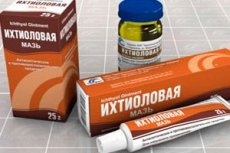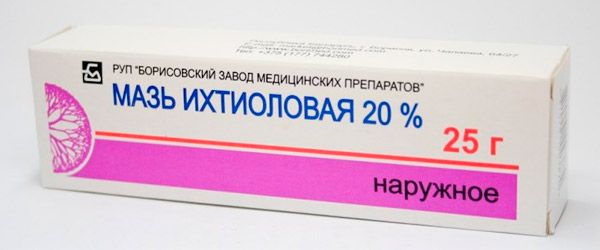Medical expert of the article
New publications
Preparations
Ichthyol ointment for acne
Last reviewed: 03.07.2025

All iLive content is medically reviewed or fact checked to ensure as much factual accuracy as possible.
We have strict sourcing guidelines and only link to reputable media sites, academic research institutions and, whenever possible, medically peer reviewed studies. Note that the numbers in parentheses ([1], [2], etc.) are clickable links to these studies.
If you feel that any of our content is inaccurate, out-of-date, or otherwise questionable, please select it and press Ctrl + Enter.

Indications ichthyol ointment for acne
Indications for the use of ichthyol ointment include the treatment of superficial and deep inflammatory skin lesions - acne vulgaris (acne), pimples, furuncles, carbuncles, erysipelas, recurrent and vesicular eczema, panaritium, abscesses, bedsores. ATC code - D08AX.
 [ 3 ]
[ 3 ]
Pharmacodynamics
Ichthyol – ammonium bituminosulfonate – is a sulfonated shale tar with a high content of sulfur compounds in the form of ammonium salts of organic sulfonic acids.
These compounds provide the pharmacodynamics of the complex effect that 10% ichthyol ointment has on acne on the face and ichthyol ointment on subcutaneous acne, as well as 20% ichthyol ointment on internal acne maturing in the deeper layers of the skin.
The ammonium salts of sulfonic acids included in ichthyol are able to penetrate intact skin and, oxidizing, absorb oxygen and liquid, “pulling out” purulent exudate accumulating in inflamed tissues, including in the ducts of the sebaceous glands (with subcutaneous and internal acne). Sulfur compounds act bactericidally, coagulating the membrane proteins of microbes that cause inflammation. The antibacterial properties of ichthyol ointment are manifested mainly in relation to gram-positive microorganisms, the invasion of which is the cause of acne.
In addition, ichthyol ointment for acne relieves inflammation not only through local irritation and improvement of intra-tissue metabolism, but also due to the release of calcium ions, inhibition of the formation of reactive oxygen species, and blocking leukotriene B4 (a lipid neurotransmitter of inflammation) in neutrophils.
Pharmacokinetics
Ichthyol ointment is a local remedy, and, referring to the lack of systemic absorption, the pharmacokinetics of the drug are not presented by the manufacturers. Although after a sufficiently long use of this ointment in the treatment of acne and pimples, the sulfur content in the urine may be increased.
 [ 4 ]
[ 4 ]
Dosing and administration
It is recommended to apply the ointment in a thin layer (without rubbing) to the damaged areas two or three times a day; when treating pimples – to their surface. Avoid contact of the ointment with mucous membranes.

Overdose of this product is not described in the instructions, but with prolonged use, a skin allergic reaction is possible.
Contraindications
Ichthyol ointment for acne is contraindicated in cases of hypersensitivity, infected burns, inflammatory processes with abundant exudation, and in children under 12 years of age.
The use of ichthyol ointment for acne during pregnancy is permitted upon the prescription of a dermatologist, if ichthyol ointment will be used for acne on the face.
Side effects ichthyol ointment for acne
Possible side effects of ichthyol ointment for acne may include the appearance of itchy rashes and hyperemia on the skin.
Shelf life
The shelf life is 5 years.
 [ 15 ]
[ 15 ]
Attention!
To simplify the perception of information, this instruction for use of the drug "Ichthyol ointment for acne" translated and presented in a special form on the basis of the official instructions for medical use of the drug. Before use read the annotation that came directly to medicines.
Description provided for informational purposes and is not a guide to self-healing. The need for this drug, the purpose of the treatment regimen, methods and dose of the drug is determined solely by the attending physician. Self-medication is dangerous for your health.

